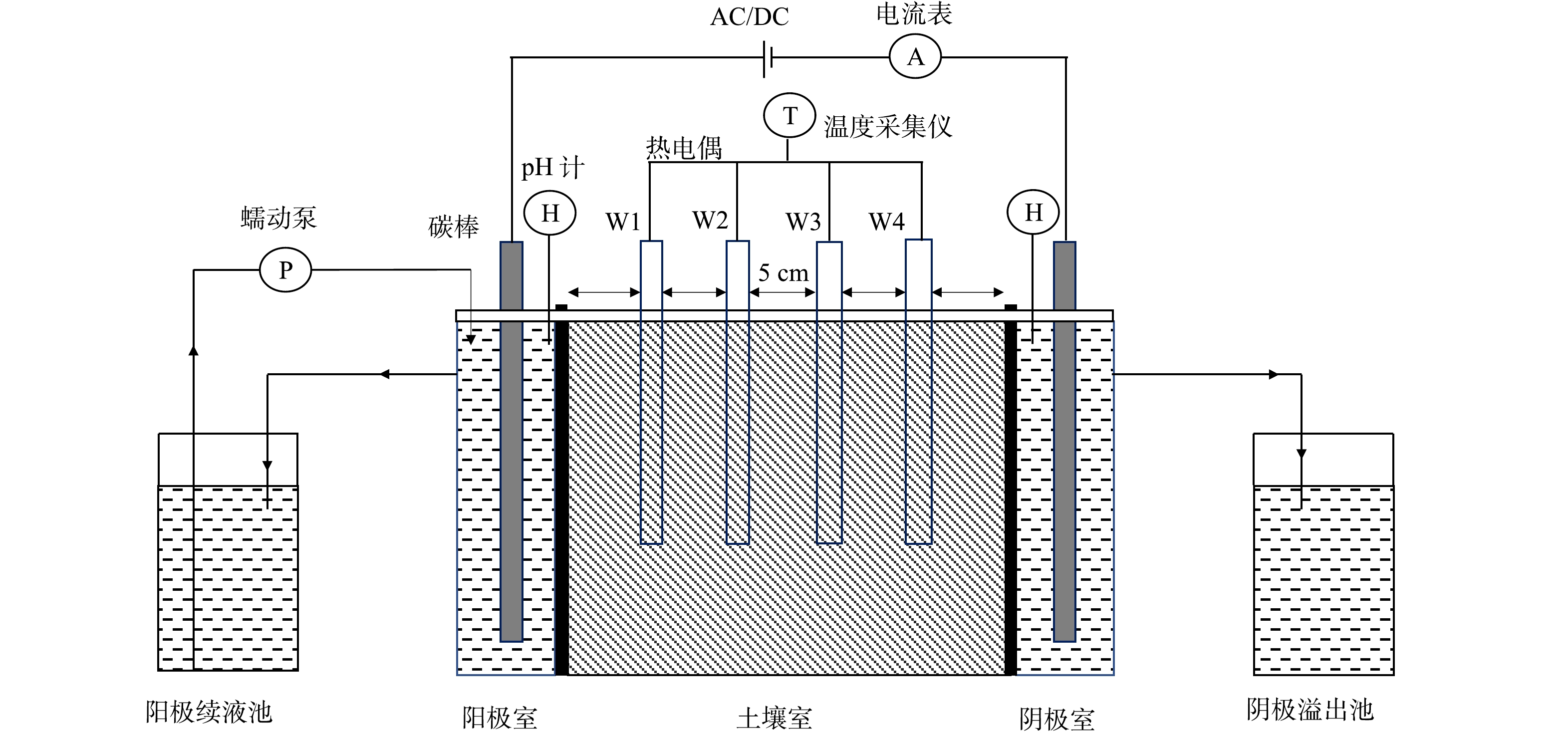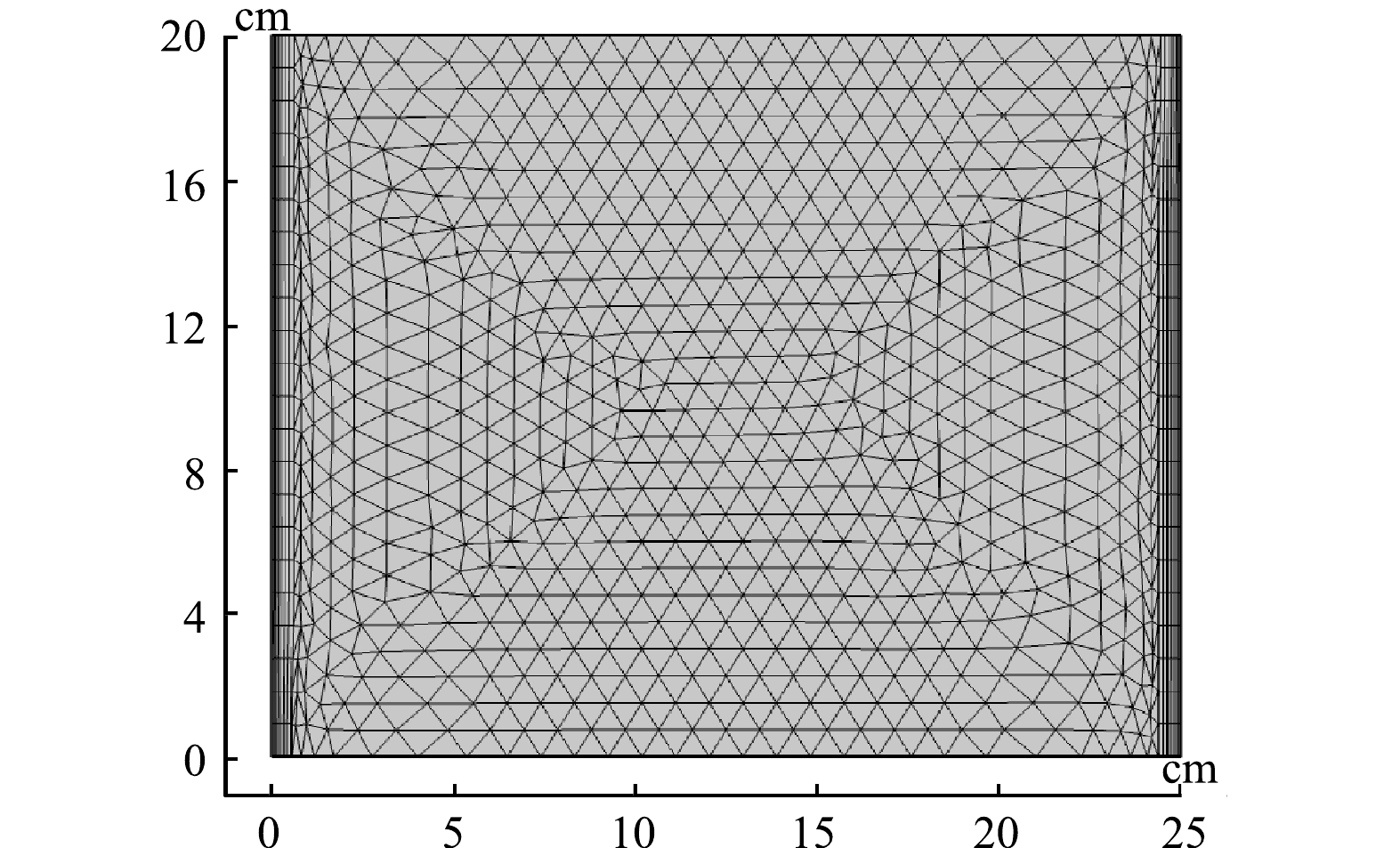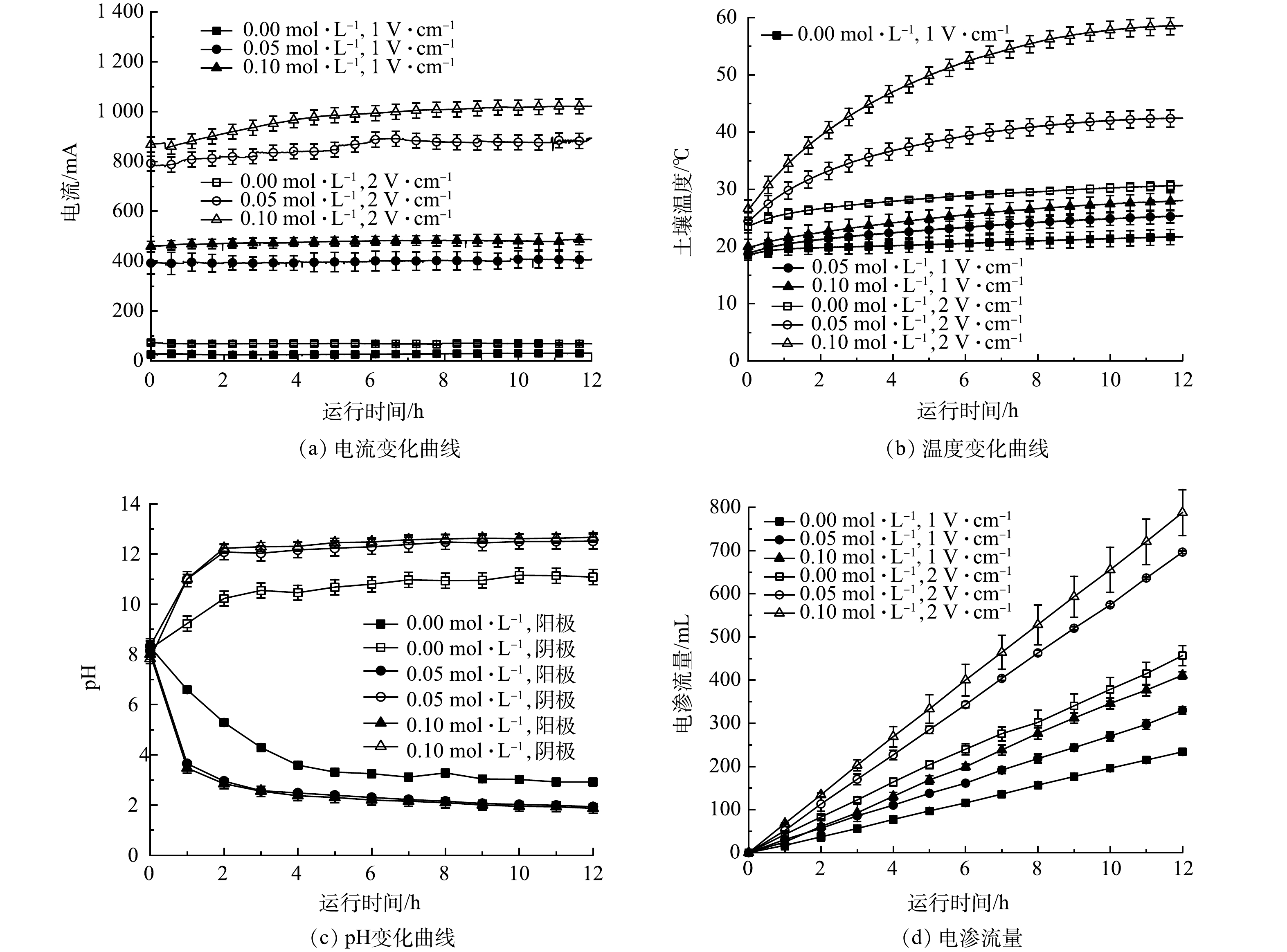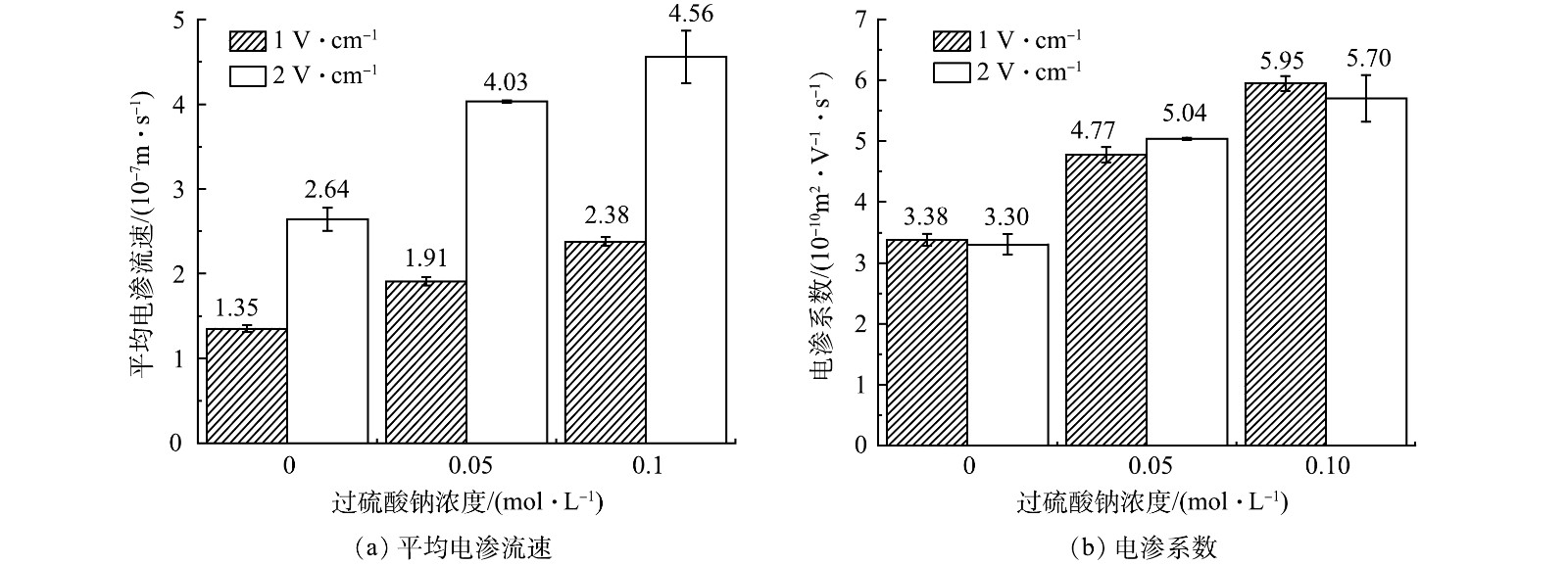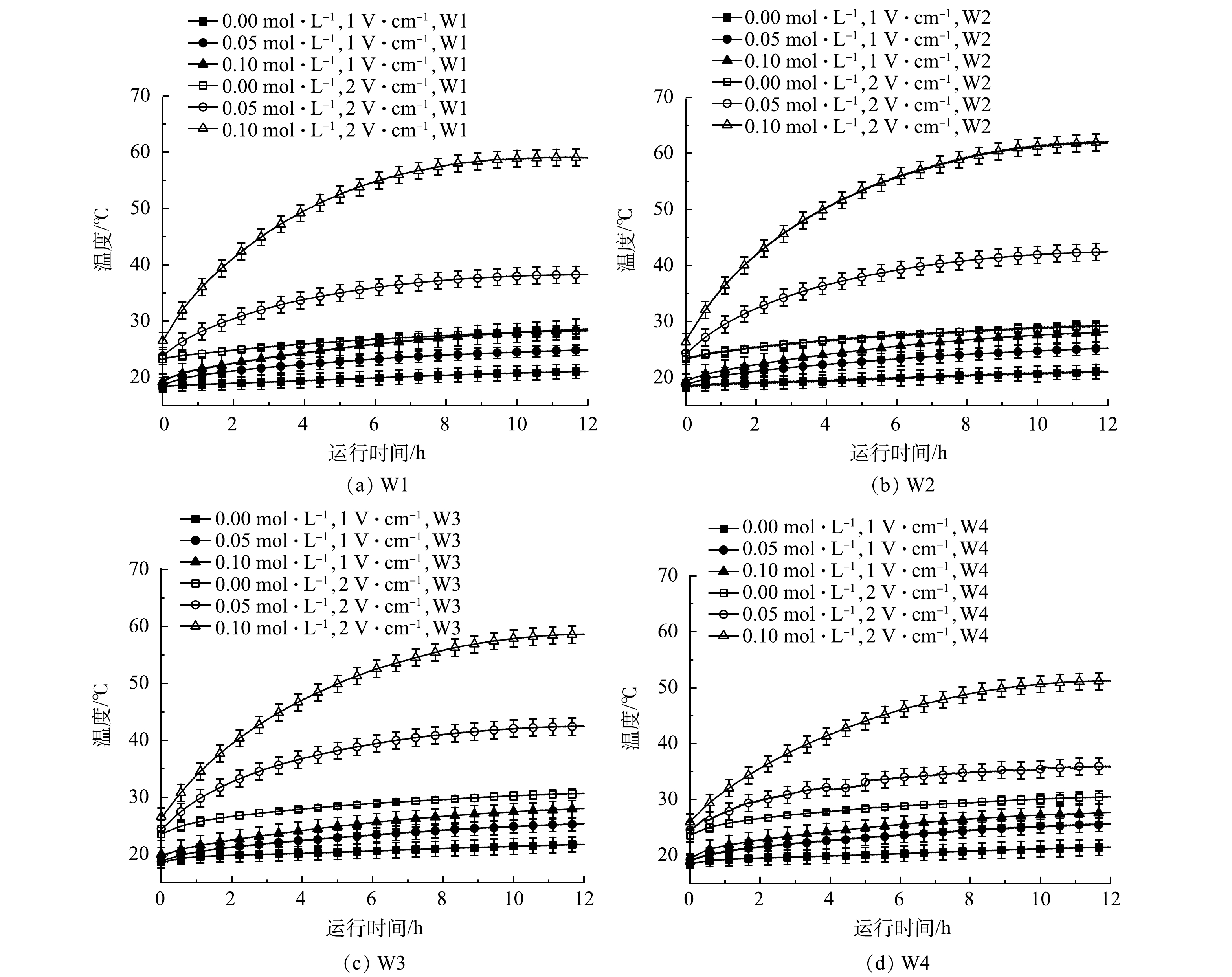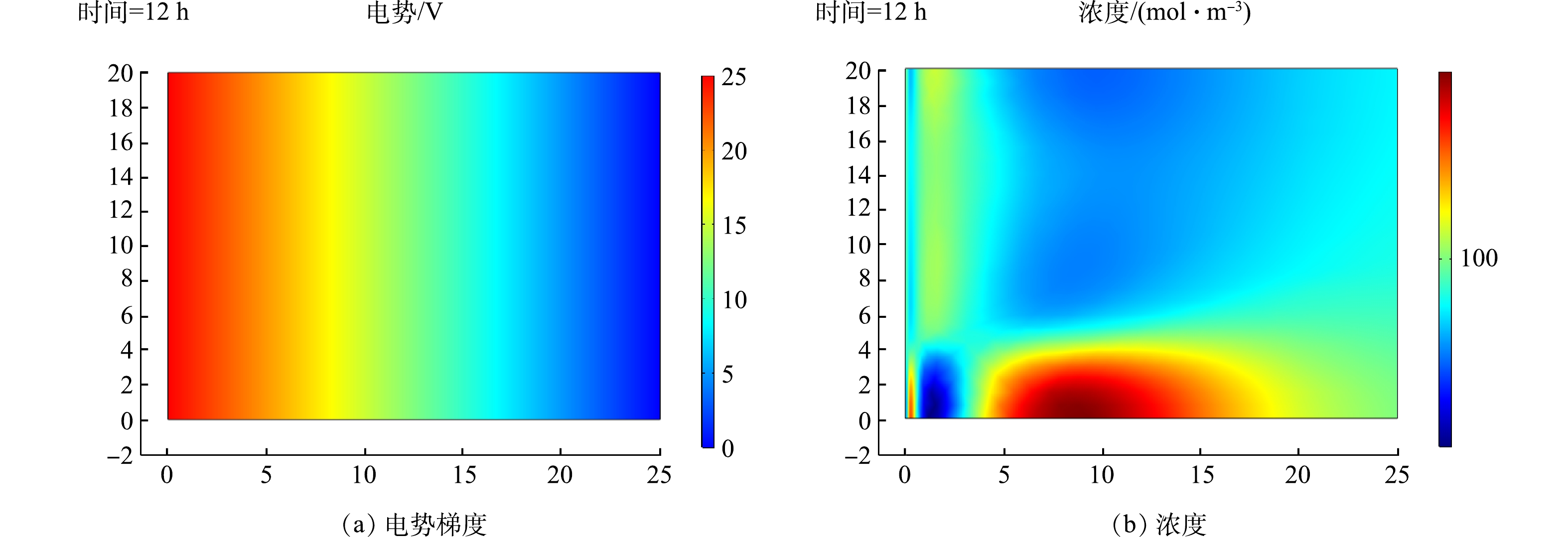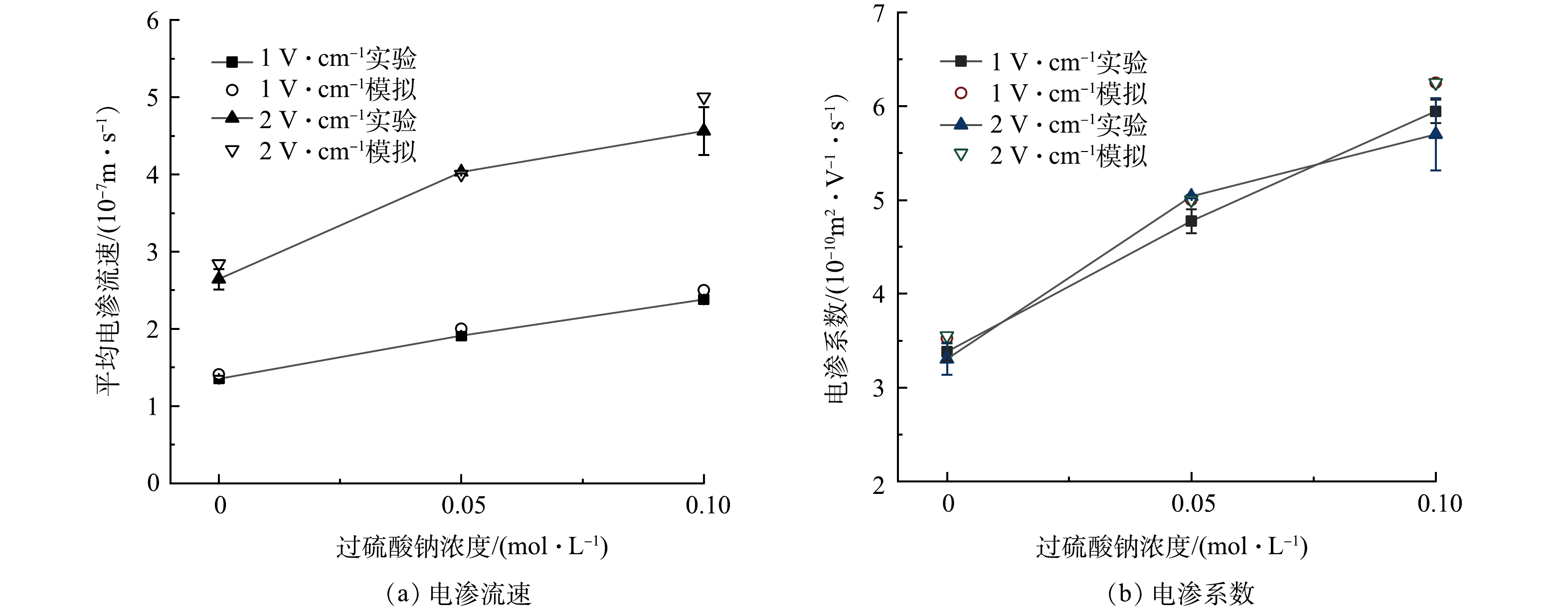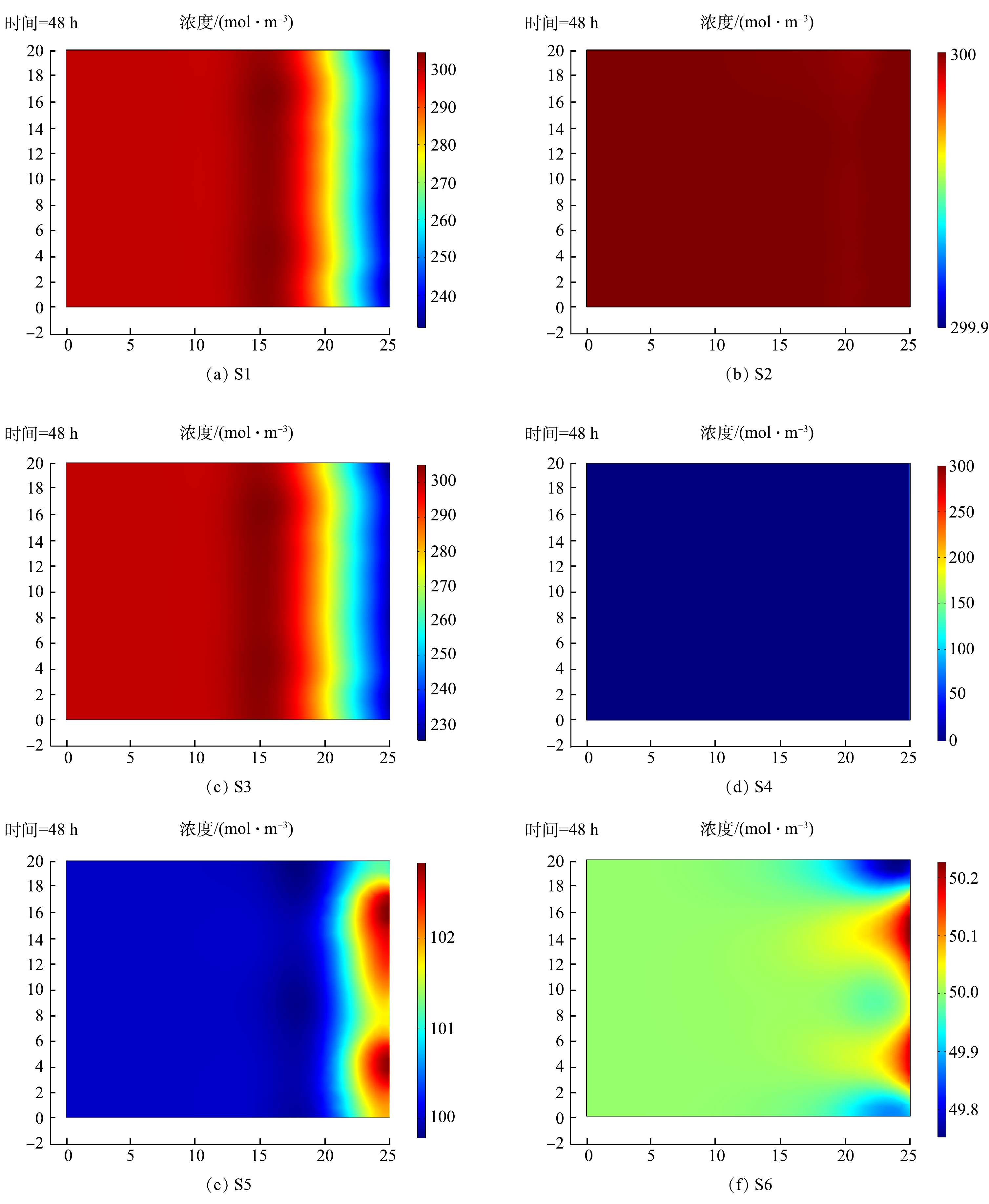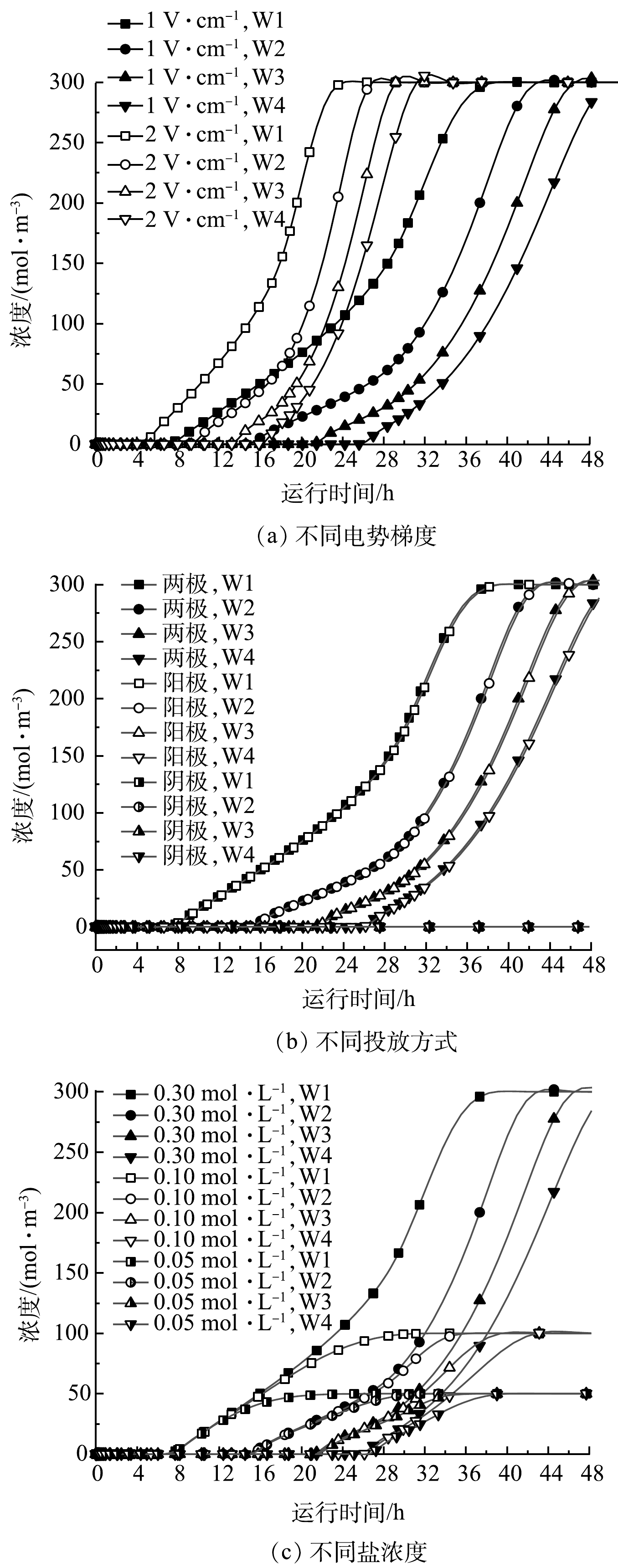-
过硫酸钠 (Na2S2O8) 是工程应用中最常见的氧化剂[1]。相比较其他的氧化剂,活化过硫酸钠的氧化性强,反应速度快,适用范围广[2]。在有机污染土壤修复中,常采用过硫酸盐高级氧化技术,主要方法是在压力下将过硫酸钠氧化剂溶液注入井内,并进一步输送至周围地下区域[3]。但在低渗透性粘土中,上述方法的过硫酸钠输送影响半径非常有限,即使加强高压喷射灌浆,过硫酸钠的输送范围也很难令人满意 [3-5],较差的传输效率限制了该技术在现场修复中的应用[5-8]。而采用电动输运替代传统的压力输运可以极大提高氧化剂的传输效率。其原理是,在污染土壤两端植入惰性电极,通入直流电,利用电场产生的各种电动效应,来驱动氧化剂沿电场方向定向迁移[9-10]。
近年来,国内外学者对于联合电动输运的过硫酸盐氧化修复技术研究已经取得了一些成果。研究发现,在电动输运中,电渗流占据了主导因素,效果要好于电迁移、扩散等其他的效应[11-14]。李永涛等[11]发现,在阳极投加过硫酸钠时,过硫酸根离子主要通过电渗流驱动进入土壤,电渗流的速度远大于电迁移。WEN等[12]发现,在低渗透性土壤中,电渗流对过硫酸钠的输送速率约为电迁移的5倍,对聚苯乙烯的传质效率约为电迁移对过硫酸钠的20倍。SPROCATI等[13]和SPROCATI等[14]建立电动输运的数值模型,模拟了乳酸和微生物的电动输运过程,发现电渗流的速度是电迁移的10倍。为探究不同变量对电渗特性的影响,胡平川[15]和陈明华[16]对软土进行电渗实验,发现电渗系数是由土壤自身的性质决定的,与外因无关,且较高的含水率和土壤含盐量 (小于1%) 的提高有利于提高电渗流速。 XU等[7]研究发现离子交换膜增强可以有效控制pH并减少过硫酸钠损失效应,从而提高多环芳烃的去除效率。郑凌逶等[17]和谢新宇等[18]研究发现,电极间距越小,相同排水效果所需的处理时间越短,在保证电渗效果效率的情况下,可以通过缩短电极间距和使用新型材料来降低能耗。廖波等[19]采用电动力学和氧化还原联合修复技术对石油污染土壤进行修复,有效降低石油污染物浓度。过硫酸盐会发生热活化反应,研究表明,温度越高,过硫酸盐的热活化效率越高[20-23]。陈丽萍等[20]、戴俊等[21]和CHOWDHURY等[22]研究发现,过硫酸盐在50 ℃条件下活化效果最佳,并以此温度作为预处理温度。任何军等[23]对过硫酸钠进行热活化实验,发现温度从40 ℃提高至60 ℃时,污染物的降解率从14%提高到了81%。但也有研究表明,过高的温度反而会带来负面影响[24-25]。侯思颖[24]对过硫酸钠进行热活化处理,发现当温度从25 ℃升高至60 ℃时,污染物的降解率从33%提高到89%,但当继续升温至80 ℃时,其反应效率却从53%下降到36%。张萍萍等[25]认为,当温度过高时,SO4·−的活性很强,但存在时间很短,因此部分SO4·−在还没有与污染物充分接触反应时便被降解,降低了修复效果。
在过硫酸盐的电动输运过程中,通过对电渗特性的研究,提高过硫酸盐的电动传输效率是一种有效的手段[12]。但是持续的电流会在一定程度上提高土壤温度,这会加快过硫酸盐的热活化效率。而在过硫酸盐的电动输运阶段,应降低这种热活化效率。而很多研究重点关注单一污染物的去除效率,而在电动输运过程中兼顾传输与活化效率的研究还比较少,同时也没有建立有效的数值模型[11-12]。在数值模型研究上,虽然有电动输运的模型,但研究对象主要为生物质和有机质,并非该技术上使用的无机盐氧化剂[13-14]。本研究以过硫酸钠氧化剂作为传输物质,进行电动输运,根据电势梯度、土壤间隙水盐浓度、过硫酸盐投放电极和浓度的不同进行实验和数值模拟研究;结合温度、pH等多因素探究对电渗流速和电渗系数的影响,以提高过硫酸盐的电动传输效率,同时尽量减少传输过程中的活化效率,以期为电动输运过硫酸盐的方案供理论依据和参考。
-
供试土壤采集于杭州某园林的表层土壤 (0~20 cm) ,挖掘土壤后去除石块、树叶等杂质,避光自然风干,研磨,过20目筛,备用。送检后测得相关物性参数如表1所示。实验使用的试剂为过硫酸钠 (Na2S2O8,98%) ;实验使用的电极材料为高纯度石墨棒 (C,99.9%) 。
实验所使用的仪器包括笔试酸度计 (pH-100,上海力辰邦西仪器科技有限公司) ;蠕动泵 (NKCP-S04B,卡川尔流体科技 (上海) 有限公司) ;数据采集仪 (34972A,是德科技 (中国) 有限公司) ;调压直流电源 (HYJ-1505E250,杭州煌洋电子有限公司) ;双光束紫外可见分光光度计 (TU-1901,北京普析通用仪器有限责任公司) ;K型铠装热电偶 (WRNK-191,颜历自动化仪表(上海)有限公司) 。
-
实验装置示意图如图1所示。主要箱体外径长40 cm,宽20 cm,高25 cm。全部装置从左至右分别为:阳极续液池 (2 L) ,阳极室 (6.5 cm×19 cm×20 cm) ,土壤室 (25 cm×19 cm×20 cm) ,阴极室 (6.5 cm×19 cm×20 cm) ,电渗溢出池 (2 L) 。阳极室、土壤室、阴极室之间用带网格的亚克力板隔开,并贴上滤纸。箱体上方的盖板中心线上,留有2个电极棒孔位、4个间隔5 cm的热电偶孔位、4个土壤采样孔位。蠕动泵使阳极续液池和阳极室进行溶液循环,保证阳极室液位不变。阴极室多余液体自然溢出至阴极溢出池。较高的土壤含水量有助于过硫酸盐在土壤中的传质过程[26],因此在实际应用中需保证土壤一定的含水率。为保证实验过程中的单一变量,在探究其电渗特性时,土壤室中的土壤将始终保持水饱和。
-
首先配置0.05、0.1 mol·L−1的过硫酸钠溶液若干,将处理后的土壤分成3份,分别加入0、0.05、0.1 mol·L−1过硫酸钠溶液至土壤达到饱和状态,同时充分搅拌土壤至均匀。然后将过硫酸钠溶液和土壤分别填充至电极室和土壤室,盖上盖板,按照预留孔位放入石墨棒和热电偶,打开数据采集仪、蠕动泵后接通电源。实验过程中,电流和温度数据由数据采集仪记录,每间隔10 s记录1次。每1 h读取并记录1次电渗流量数据。同时对土壤采样,处理后通过笔试酸度计测得上清液pH,实验结束后,关闭实验设备并进行土壤采样。实验分别在土壤间隙水初始过硫酸钠盐浓度0、0.05、0.1 mol·L−1和电势梯度1、2 V·cm−1下进行,运行时间为12 h,共计6组实验工况,每组工况进行3组平行实验,进行误差分析,以排除实验的偶然影响。实验工况表如表2所示。
-
累计电渗流通过每小时将阴极溢出池溶液倒入量筒读数,并记录读数和累加,并通过计算得到电渗速度以及电渗系数。电渗速度计算公式如式(1)所示,电渗系数计算公式如式(2)所示。
式中:veo为电渗速度,m·s−1;V为电渗流体积,m3;n为孔隙率,无量纲;S为截面积,m−2;t为时间,s;keo为电渗系数m2·V−1·s−1;,▽V为电势梯度,V·m−1。
过硫酸钠浓度使用紫外分光光度计测得样品吸光度,与标准曲线比对,计算得到土壤过硫酸钠浓度。检测方法参考文献[27],计算公式如式(3)所示,标准曲线如式(4)所示。
式中:
wliq 为浸提液的过硫酸钠质量浓度,mg·L−1;A为试样的吸光度,无量纲;A0为空白试样的吸光度,无量纲;b为标准曲线的截距,mg·L−1;k为标准曲线的斜率,mg·L−1。标准曲线的横坐标x为吸光度A-A0,无量纲;纵坐标y为为浸提液的过硫酸钠质量浓度wliq ,mg·L−1。土壤pH在水土比1 g∶2.5 mL下进行,测定方法参考文献[11]。
-
在低渗透多孔介质中,不考虑地下水流动时,带电粒子的通量可以用能斯特普朗克 (Nernst-Planck) 方程描述,总方程如式(5)所示。
式中:Ji表示组分i的总通量,mol·m−2·s−1;JiDif表示组分i的扩散通量,mol·m−2·s−1;JiMig表示组分i的迁移通量,mol·m−2·s−1;JiEo表示组分i的电渗通量,mol·m−2·s−1。
扩散通量方程、迁移通量方程、电渗通量方程如式(6)~式(8)所示。
式中:n为土壤孔隙度,无量纲;
∇ ci为摩尔浓度梯度,mol·m−3·m−1 ;Di为孔隙扩散系数,m2·s−1。其中,孔隙扩散系数可由式Di=Diaqτ 计算,Diaq为水的扩散系数,m2·s−1;τ为弯曲度,无量纲;zi为组分i的电荷,无量纲;F为法拉第常数,C·mol−1;ci为组分i的浓度,mol·m−3;∇V 为电势梯度,V·cm−1;u可用能斯特-爱因斯坦方程描述u=DiRT ,R为气体常数,J·mol−1·K−1;T为温度,K;veo 为电渗流速,m·s−1。考虑到物质平衡,可以推导出多组分的离子迁移运输方程,如式(9)所示。
式中:
Ri 为源汇项,mol·m−3·s−1。溶液电荷密度
ρε 与电场的关系可由泊松方程描述,如式(10)所示。式中:
ρε 为溶液电荷密度,C·m−3;ε 为多孔介质的介电常数,F·m−1;N为溶液中带电物质的数量,无量纲。在电解质体系中,考虑到土壤孔隙中的水溶液是其电导率的主要贡献来源,可以假设电流是由溶液中的离子携带的。因此,可以将电流密度I表示为系统中离子的总通量,如式(11)所示。
式中:
I 为电流密度,A·m−2。以电荷表示的连续性条件如式(12)所示。
-
按照实验装置同比例定义几何模型。模型只保留主要部分土壤室,其他装置及反应条件均以边界条件体现。并在中心位置每间隔5 cm在相同位置放置域点探针,用于测量。在物理场的选择上,使用电流模块和稀物质传递模块,并根据实际情况设置初始值、边界条件、电绝缘、流入、流出与浓度等具体参数。最后定义有限单元网格,并选择合适的求解器并使结果可视化。几何模型如图2所示,该模型为箱体装置的主视图。
在电流模块中,模型的上下边界设置为电绝缘,左侧为阳极,电势Vanode根据工况分别设置为25、50 V,右侧为阴极,电势始终为0 V,由此构建一个从左至右的平均1、2 V·cm−1的初始电势梯度,随着不同位置过硫酸盐浓度的改变,不同位置的电势梯度也将随着改变。
在该稀物质传递模块中,上下边界为装置外壳,设为无通量,左右边界可根据过硫酸钠的投放电极设置浓度边界或流出边界。若该电极为投放电极,则根据投放浓度设50、100、300 mol·m−3的浓度边界,分别对应0.5、0.1、0.3 mol·L−1的投加浓度;若电极为非投放电极,则设为流出边界,作为自由的开放边界。土壤中的过硫酸盐浓度按照不同工况配置土壤的实际浓度分别设置为0、50、100 mol·m−3。
数值模拟研究分为2部分,第一部分为实验结果验证,包括SA1~3、SB1~3共计6个工况,与实验部分相同,以验证模型的准确性和可靠性。第二部分为传输特性的进一步研究,包括S1~S6共计6个工况,研究在电势梯度1、2 V·cm−1、过硫酸钠投放浓度0.5、0.1、0.3 mol·L−1和不同投放电极下进行,模拟工况如表3。
-
电渗流是过硫酸盐在电动输运过程中的主要传输方式。在进行6种工况的3组重复性实验后,从电流、温度、pH、土壤间隙水盐浓度、电势梯度多因素对电渗流量、电渗流速、电渗系数展开电渗特性分析。
1) 电流、温度和pH。 各工况的电流曲线如图3(a)所示,W3测点的温度变化如图3(b)所示,电渗流量变化如图3(d)所示,不同浓度过硫酸盐阳极液和阴极液的pH值变化如图3(c)所示。从图3(a)可以看出,各工况在运行过程中,电流是趋于稳定的。由欧姆定律可知,当电压一定时,电流不变,则电阻也不变。而阳极室和阴极室充满电解质溶液,导电性较强,因此箱体的总电阻取决于土壤电阻。由于土壤的导电能力主要来源于多孔介质中的电解质溶液中的可自由移动离子[12]。这说明,整个实验过程中,土壤室中的总离子数是趋于稳定的,并没有因为阳极室溶液的流入和阴极室溶液的流出而改变。同时,对比图4可以看出,电流大小与电渗流速和电渗系数并没有直接的规律。在研究电渗系数的相关文献[15-16]中,也并未提及电流对电渗流速和电渗系数的关系。因此,电流大小与电渗流可能没有关联。从图3(d)可以看出,各工况的电渗流量随着运行时间几乎是成正比增加的,各个工况的电渗流速近似是匀速的,但将电渗流速曲线拆成0~4、4~8、8~12 h 这3部分后,计算每段小曲线的拟合斜率,可以得到,各工况从4 h到8 h到12 h,其电渗流速平均提高比例为19.3%和14.5%。由于电势梯度等外部因素不变,这一变化可能是土壤内因的变化引起的。研究发现,电渗系数是土壤自身的属性,与pH、温度等内因均有关系,电渗系数的变化会直接引起电渗流速的变化[15-16]。从图3(b)可以看出,各工况温度在8 h前变化较大,而后趋于稳定,各工况中温度最高达到了60 ℃;从图3(c)可以看出,pH在前4 h变化较大,而后趋于稳定,各工况中pH变化的最大范围为2~12。因此,在电势梯度恒定,土壤导电性能稳定的情况下,不考虑其他因素的影响,引起该电渗流速变化的原因,可能是温度升高和电极液酸碱化引起的电渗系数变化,其中温度变化引起的电渗增益为14.5%,pH引起的电渗增益为4.8%。在3组平行实验中,电流的最大误差为3.46%,温度的最大误差为2.9%,pH的最大误差为0.02,电渗流量的最大误差为6.72%,实验的整体误差较小,重复性高,具有一定可靠性。
2) 不同间隙水盐浓度。各工况的平均电渗流速和电渗系数结果如图4所示。在1 V·cm−1的电势梯度下,间隙水盐浓度从0 mol·L−1分别提高至0.05、0.1 mol·L−1时,其电渗流速分别提高41.5%、76.3%,而电渗系数提高比例分别为41.1%,76.0%;而在2 V·cm−1的电势梯度下,电渗系数提高的比例为52.6%、72.7%,电渗系数提高比例为52.7%、72.7%。可见,在1、2 V·cm−1的电势梯度下,当间隙水盐浓度从0 mol·L−1分别提高至0.05 mol·L−1时,电渗流速和电渗系数的提高非常显著,而间隙水盐浓度再次提高到0.1 mol·L−1,仍有一定的提升效果,但相较于之前的提高明显降低了。这可能是因为,过高的盐浓度 (2%) 会抑制电渗的进行,使电渗流量减少[15]。所以,随着土壤间隙水盐浓度的提高,这种提升的效果会越来越不明显,甚至会起到抑制作用,但当间隙水盐浓度低于0.1 mol·L−1时,可以通过提高土壤间隙水盐浓度来提高电渗流量,且浓度越低效果越明显。另外还发现,电渗流速和电渗系数的提高比例接近,没有明显区别。因此,提高间隙水盐浓度可对提高电渗流速和土壤电渗系数有相同的效果。由于土壤电渗系数是土壤的属性,而电渗流速是表观的结果,因此提高土壤间隙水盐浓度对电渗流速的提高,其原因可能是提高了土壤的电渗系数。
3) 不同电势梯度。各工况的平均电渗流速和电渗系数结果如图4所示。在0.05 mol·L−1的间隙水盐浓度下,电势梯度从1 V·cm−1提高到2 V·cm−1时,其电渗流速提高了111.0%,而电渗系数提高了5.7%。在0、0.1 mol·L−1的间隙水盐浓度下,电渗流速的提高的比例分别为95.6%和91.6%,而电渗系数反而降低了,降低的比例分别为2.4%和4.2%。由此可见,当土壤间隙水盐浓度一定时,提高电势梯度可以显著地提高电渗流速,提升的最低百分比接近100%。但土壤电渗系数的变化幅度很小,且变化的情况也并无规律。这是因为,电势梯度的改变属于外因,和土壤本身无关。因此,电势梯度的改变不能影响土壤电渗系数[15]。而这些电渗系数的微小的变化,可能是由于土壤中可移动离子总量、温度、pH等多种土壤内因导致的。在本实验中,这种内因导致的电渗系数的改变最大为5.7%,相比较电势梯度提高带来的电渗增益是影响较小的。因此,在讨论对电渗流速与电渗系数的增幅时,可以对效果进行修正后忽略其影响;同时,也对其产生的具体原因不作深入探讨。若使用上一节中的结论,将电渗系数的变化以相同比例折算进电渗流速后,在0、0.05、0.1 mol·L−1的间隙水盐浓度下,电势梯度从1 V·cm−1提高到2 V·cm−1时,其电渗流速提高的比例分别为105.3%、98.0%、95.8%,都较为接近100%,最大差距为5.3%。因此,当盐浓度一定时,提高电势梯度可以以接近相同比例的效果提升电渗流速。
-
过硫酸盐在电动输运过程中,除了电渗流的主导因素外,还存在电迁移、扩散等迁移方式,同时在电流热效应下,土壤升温,在一定程度上也会加快过硫酸盐的热活化效率。对土壤中过硫酸盐实验前后的质量分数进行测量,分析其电动输运特性和热活化带来的影响。
1) 过硫酸盐电动输运特性。不同工况实验各测点温度变化如图5所示。可以看出,在同一工况中,不同位置的土壤的升温趋势是相同的,4个测点的温度整体上呈现W1=W2>W3>W4的趋势。由电流的热效应公式可知,串联电路中,电阻越大,产热越大,温度越高。由此可知,将土壤室看作W1~W4的串联电阻后,不同位置测点的电阻呈现RW1=RW2>RW3>RW4的趋势。电阻越大,说明可移动离子越少,即各测点的离子浓度分布为靠近阴极侧居多。虽然土壤室中离子的整体数量趋于稳定,但是离子有向阴极富集的趋势。这是因为,电动输运的方向本就是阳极到阴极的,同时也验证了在电动输运过程中,电渗流的作用要远大于电迁移和扩散。同时,由于阴极室也充满了该浓度的过硫酸钠溶液,当富集过程不断继续,随着阴极附近离子浓度不断的增加,使得该区域由阴极向阳极方向的电迁移作用和扩散作用得到了增强,电渗作用一定程度上受到了抑制,这也在一定程度上,导致了该现象的形成。
2) 热活化对过硫酸盐电动输运结果的影响。不同工况实验前后W1~W4各测点过硫酸根质量分数如表4所示。计算得到的各工况各测点的最终温度及对应的过硫酸根余量如表5所示。可以看出,实验后,过硫酸根的质量分数有了明显下降。这是因为,过硫酸根在受热时进行了热活化反应,产生了具有强氧化能力的自由基。对照表5可以得到不同温度下,过硫酸根的热活化效果。在运行12 h后,当最大温度低于30 ℃时, 过硫酸根的最大剩余量为84.6%;当温度达到51 ℃时,过硫酸根的最大剩余量为51%;当温度达到62 ℃时,过硫酸根的最大剩余量仅剩34.9%。随着温度的升高,相同时间内过硫酸根的活化效果急剧增加。因此,在过硫酸盐的电动输运过程中,将温度控制在30 ℃内,可以使过硫酸根在最大程度上得到保留。而全部测点的温度均低于30 ℃的工况均采用了1 V·cm−1的电势梯度,此时即使盐浓度提高到0.1 mol·L−1仍可保证最高温度低于30 ℃。当电势梯度提高至2 V·cm−1,随着盐浓度的提高,温度升高效果明显,不适应于过硫酸盐的传输阶段,待电动输运完成后,方可提高电势梯度进行热活化。
-
使用数值模型模拟实验工况,验证模型的可靠性。在不同电势梯度、过硫酸盐投放电极和投放浓度条件下,模拟过硫酸的输运过程,进一步分析其电动输运特性,探究最佳输运方案。
1) 模型验证。在1、2 V·cm−1的电势梯度和0.1 mol·L−1的土壤孔隙水盐浓度下,电势分布及过硫酸盐浓度分布如图6所示。各工况的电渗流量和电渗系数结果实验和模拟对比如图7所示。由图6可以看出,在运行结束后,过硫酸盐的浓度分布和电势梯度都较为均匀,与实验结果一致。由图7可以看出,实验与模拟计算得到电渗流量和电渗系数结果较为接近,最大误差仅为7.5%。因为在电动输运过程中,电渗流的输运效率是电迁移等其他因素的总和的5倍,占据主导因素[12]。因此,在电渗特性上结果一致可以说明模型是可靠的,即使电迁移等模拟结果有误差,对电动输运结果的影响最大不超过16.7%。由于数值模型未引入活化方程,对过硫酸根热活化分解的情况无法模拟,但在认为模型可靠的基础上,对比输运后过硫酸盐的浓度以及实验检测的过硫酸根质量分数,如图6和表4的数据对比,可以计算得到不同位置过硫酸盐的活化效率。
2) 不同电势梯度。分别在1、2 V·cm−1的电势梯度下,两极投放0.3 mol·L−1过硫酸钠运行48 h后,过硫酸根浓度分布如图8(a)~图8(b)所示,各测点过硫酸盐浓度变化曲线如图9(a)所示。由图8可以看出,在运行48 h后,过硫酸盐分布均匀,在1 V·cm−1电势梯度下,过硫酸盐达到W1~W4测点的时间为8、15、21、26 h。其中,W1~W3达到稳定的时间为38、43、47 h,W4测点最终浓度为0.28 mol·L−1,暂未达到稳定状态;在2 V·cm−1电势梯度下,过硫酸盐达到W1~W4测点的时间为5、10、13、16 h,W1~W4达到稳定的时间为24、27、29、31 h。因此,提高电势梯度可以显著提高过硫酸盐的传输效率,但对于最终的过硫酸盐的传输结果影响较小。当电势梯度从1 V·cm−1提高到2 V·cm−1时,达到相同输运结果的时间只需要原先的61%。由本研究可知,在该电势梯度下,土壤升温明显。因此,虽然提高电动输运过硫酸盐的电势梯度可以有效缩短传输时间,但需要对土壤进行降温以减少过硫酸盐的热活化反应,在实际应用中成本过大,缺少可行性。如果修复场地位于气候寒冷的季节或地区,例如在我国北方的冬季进行修复时,可利用天然环境对土壤进行降温,当工程修复时间短,需要在较短时间达到修复目标时,可以考虑适当提高电势梯度,并在输运阶段需对土壤进行温度监测,尽量控制土壤温度不超过30 ℃。
3) 不同投放方式。分别在阳极、阴极、两极投放0.3 mol·L−1过硫酸钠,在1 V·cm−1电势梯度下运行48 h后,过硫酸根浓度分布如图8(a)、图8(c)、图8(d)所示,各测点过硫酸盐浓度变化曲线如图9(b)所示。可以发现,当选择将过硫酸盐投放在阳极或两级时,对于最终的过硫酸盐分布影响不大,各测点平均浓度差仅为1%;而当仅在阴极投放过硫酸盐时,土壤中几乎没有过硫酸盐。虽然有机污染物同样会随着电动输运向阴极迁移,但是效率较低[28-29]。因此,仅在阴极投放过硫酸盐无法使氧化剂渗透全部修复区域,只能寄托于污染物向阴极迁移达到修复目标,由此会导致修复时间长和修复效果差的问题。因此,在电动输运过硫酸盐时,建议将过硫酸盐投放在两级或阳极,不建议仅在阴极投放过硫酸盐。若预算充足,仍然建议同时在两级投放过硫酸盐,虽然对于土壤的修复预期接近,但是阴极投放的过硫酸盐可以使得迁移的污染物达到阴极后全部被还原,不会造成二次污染[30]。
4) 不同投放浓度。分别在两极投放0.05、0.1、0.3 mol·L−1过硫酸钠,在1 V·cm−1电势梯度下运行48 h后,过硫酸根浓度分布如图8(a)、图8(e)、图8(f)所示,各测点过硫酸盐浓度变化曲线如图9(c)所示。由图8(a)、图8(e)、图8(f)可看出,投放不同浓度的过硫酸盐,达到稳定时的最终浓度不同,分别为0.3、0.1、0.05 mol·L−1,因此提高过硫酸盐投放浓度可以提高最终的过硫酸盐浓度。由图9(c)可以看出,过硫酸盐到达W1~W4测点的时间接近,均为8、15、21、26 h,且各测点浓度前期上升速率接近;但当浓度接近投放浓度时,其速率会减慢。当投放浓度分别为0.05、0.1、0.3 mol·L−1时,高浓度工况到达低浓度的稳定浓度的时间可以减少5 h,并仍然保持较高的输运速率。因此,可以适当提高投放的过硫酸盐浓度,以提高过硫酸盐的传输效率,缩短输运时间。
-
1) 为提高过硫酸盐的电动输运效果,可以通过提高电势梯度和增加土壤盐浓度的方式来提高电渗流效果,其中土壤盐浓度可通电动输运过硫酸盐来提高;而温度和pH对电渗的效果不显著,在实际应用中可以忽略。
2) 提高电势梯度会提高土壤的温度,加快过硫酸盐的热活化效果,建议使用1 V·cm−1的电势梯度,使土壤温度不超过30 ℃;若修复场地气候寒冷,则可以考虑适当提高电渗梯度以提高电动输运效率,但需对土壤进行温度监测。
3) 过硫酸盐投放电极建议选择两极同时投放;当投放浓度不超过0.3 mol·L−1时,可以通过提高过硫酸盐投放浓度以提高电动输运效果。
过硫酸盐在土壤中的电动输运特性
Electric transport characteristics of persulfate in soil
-
摘要: 为提高过硫酸盐氧化剂在土壤中的传输效率,对以电渗流为主导因素的电动输运特性进行研究。通过土壤箱体的实验和数值模拟,研究电势梯度、土壤间隙水盐浓度和温度、过硫酸钠投放电极和浓度、pH对电渗流速和电渗系数影响,并分析过硫酸盐电动输运特性。结果表明,过硫酸盐在阳极投放与在两极投放时电动输运效果较好;提高投放的过硫酸盐浓度可以同比例提高相同时刻土壤中的过硫酸根浓度,但不改变电动输运所需的时间;提高电势梯度可以等比例提高电渗流速,但不能提高电渗系数;提高盐浓度可使电渗流速和电渗系数以相同比例提高;土壤升温至60 ℃和在2~12区间内的pH改变对电渗流速和电渗系数的提高比例为14.5%和4.8%;当盐浓度低于0.1 mol·L−1时,在1、2 V·cm−1的电势梯度下,土壤的最大温升分别为8 ℃、40 ℃。因此,在过硫酸盐的电动输运过程中,建议采用1V·cm−1电势梯度以降低过硫酸盐的活化速率。本研究结果可为电动输运过硫酸盐的传输方案提供参考。Abstract: In order to improve the transport efficiency of persulfate oxidants in soil, the electric transport characteristics with the electric seepage as the main factor were studied. Through the experiment and numerical simulation of the soil box, the effects of the potential gradient, the concentration and temperature of water and salt in the soil gap, the sodium persulfate electrode and the concentration, the pH value on the electroosmotic velocity and the electroosmotic coefficient were studied, and the electrokinetic transport characteristics of persulfate were analyzed. The results showed that the electric transport effect of persulfate was better when it was placed at anode and poles. Increasing the persulfate concentration could increase the persulfate concentration in the soil at the same time in the same proportion, but did not change the time required for electric transport; The electro seepage velocity could be proportionally increased by increasing the potential gradient, but the electro permeability coefficient could not be increased. With the increase of soil salt concentration, the electro seepage velocity and the electro permeability coefficient could be increased in the same proportion. When the soil temperature rose to 60 ℃ and the pH value changed in the range of 2~12, the electro seepage velocity and electro permeability coefficient increased by 14.5% and 4.8% respectively. When the soil salt concentration was lower than 0.1 mol·L−1, the maximum temperature rise of soil was 8 ℃ and 40 ℃ respectively under the potential gradient of 1 V·cm−1 and 2 V·cm−1. Therefore, 1V·cm−1 potential gradient was recommended to reduce the activation rate of persulfate in the electrokinetic transport process. This study will provide theoretical reference for electric transport of persulfate.
-
过硫酸钠 (Na2S2O8) 是工程应用中最常见的氧化剂[1]。相比较其他的氧化剂,活化过硫酸钠的氧化性强,反应速度快,适用范围广[2]。在有机污染土壤修复中,常采用过硫酸盐高级氧化技术,主要方法是在压力下将过硫酸钠氧化剂溶液注入井内,并进一步输送至周围地下区域[3]。但在低渗透性粘土中,上述方法的过硫酸钠输送影响半径非常有限,即使加强高压喷射灌浆,过硫酸钠的输送范围也很难令人满意 [3-5],较差的传输效率限制了该技术在现场修复中的应用[5-8]。而采用电动输运替代传统的压力输运可以极大提高氧化剂的传输效率。其原理是,在污染土壤两端植入惰性电极,通入直流电,利用电场产生的各种电动效应,来驱动氧化剂沿电场方向定向迁移[9-10]。
近年来,国内外学者对于联合电动输运的过硫酸盐氧化修复技术研究已经取得了一些成果。研究发现,在电动输运中,电渗流占据了主导因素,效果要好于电迁移、扩散等其他的效应[11-14]。李永涛等[11]发现,在阳极投加过硫酸钠时,过硫酸根离子主要通过电渗流驱动进入土壤,电渗流的速度远大于电迁移。WEN等[12]发现,在低渗透性土壤中,电渗流对过硫酸钠的输送速率约为电迁移的5倍,对聚苯乙烯的传质效率约为电迁移对过硫酸钠的20倍。SPROCATI等[13]和SPROCATI等[14]建立电动输运的数值模型,模拟了乳酸和微生物的电动输运过程,发现电渗流的速度是电迁移的10倍。为探究不同变量对电渗特性的影响,胡平川[15]和陈明华[16]对软土进行电渗实验,发现电渗系数是由土壤自身的性质决定的,与外因无关,且较高的含水率和土壤含盐量 (小于1%) 的提高有利于提高电渗流速。 XU等[7]研究发现离子交换膜增强可以有效控制pH并减少过硫酸钠损失效应,从而提高多环芳烃的去除效率。郑凌逶等[17]和谢新宇等[18]研究发现,电极间距越小,相同排水效果所需的处理时间越短,在保证电渗效果效率的情况下,可以通过缩短电极间距和使用新型材料来降低能耗。廖波等[19]采用电动力学和氧化还原联合修复技术对石油污染土壤进行修复,有效降低石油污染物浓度。过硫酸盐会发生热活化反应,研究表明,温度越高,过硫酸盐的热活化效率越高[20-23]。陈丽萍等[20]、戴俊等[21]和CHOWDHURY等[22]研究发现,过硫酸盐在50 ℃条件下活化效果最佳,并以此温度作为预处理温度。任何军等[23]对过硫酸钠进行热活化实验,发现温度从40 ℃提高至60 ℃时,污染物的降解率从14%提高到了81%。但也有研究表明,过高的温度反而会带来负面影响[24-25]。侯思颖[24]对过硫酸钠进行热活化处理,发现当温度从25 ℃升高至60 ℃时,污染物的降解率从33%提高到89%,但当继续升温至80 ℃时,其反应效率却从53%下降到36%。张萍萍等[25]认为,当温度过高时,SO4·−的活性很强,但存在时间很短,因此部分SO4·−在还没有与污染物充分接触反应时便被降解,降低了修复效果。
在过硫酸盐的电动输运过程中,通过对电渗特性的研究,提高过硫酸盐的电动传输效率是一种有效的手段[12]。但是持续的电流会在一定程度上提高土壤温度,这会加快过硫酸盐的热活化效率。而在过硫酸盐的电动输运阶段,应降低这种热活化效率。而很多研究重点关注单一污染物的去除效率,而在电动输运过程中兼顾传输与活化效率的研究还比较少,同时也没有建立有效的数值模型[11-12]。在数值模型研究上,虽然有电动输运的模型,但研究对象主要为生物质和有机质,并非该技术上使用的无机盐氧化剂[13-14]。本研究以过硫酸钠氧化剂作为传输物质,进行电动输运,根据电势梯度、土壤间隙水盐浓度、过硫酸盐投放电极和浓度的不同进行实验和数值模拟研究;结合温度、pH等多因素探究对电渗流速和电渗系数的影响,以提高过硫酸盐的电动传输效率,同时尽量减少传输过程中的活化效率,以期为电动输运过硫酸盐的方案供理论依据和参考。
1. 材料与方法
1.1 实验材料和设备
供试土壤采集于杭州某园林的表层土壤 (0~20 cm) ,挖掘土壤后去除石块、树叶等杂质,避光自然风干,研磨,过20目筛,备用。送检后测得相关物性参数如表1所示。实验使用的试剂为过硫酸钠 (Na2S2O8,98%) ;实验使用的电极材料为高纯度石墨棒 (C,99.9%) 。
表 1 土壤物性参数Table 1. Soil physical property parameters密度/(kg·m−3) 电导率/(μS·cm−1) 导热系数/(W·m−1·K−1) pH 有机质/(g·kg−1) 无机质/% 氮 磷 钾 1700 162.9 0.41 8.00 3.18 0.015 0.048 1.52 实验所使用的仪器包括笔试酸度计 (pH-100,上海力辰邦西仪器科技有限公司) ;蠕动泵 (NKCP-S04B,卡川尔流体科技 (上海) 有限公司) ;数据采集仪 (34972A,是德科技 (中国) 有限公司) ;调压直流电源 (HYJ-1505E250,杭州煌洋电子有限公司) ;双光束紫外可见分光光度计 (TU-1901,北京普析通用仪器有限责任公司) ;K型铠装热电偶 (WRNK-191,颜历自动化仪表(上海)有限公司) 。
1.2 实验装置
实验装置示意图如图1所示。主要箱体外径长40 cm,宽20 cm,高25 cm。全部装置从左至右分别为:阳极续液池 (2 L) ,阳极室 (6.5 cm×19 cm×20 cm) ,土壤室 (25 cm×19 cm×20 cm) ,阴极室 (6.5 cm×19 cm×20 cm) ,电渗溢出池 (2 L) 。阳极室、土壤室、阴极室之间用带网格的亚克力板隔开,并贴上滤纸。箱体上方的盖板中心线上,留有2个电极棒孔位、4个间隔5 cm的热电偶孔位、4个土壤采样孔位。蠕动泵使阳极续液池和阳极室进行溶液循环,保证阳极室液位不变。阴极室多余液体自然溢出至阴极溢出池。较高的土壤含水量有助于过硫酸盐在土壤中的传质过程[26],因此在实际应用中需保证土壤一定的含水率。为保证实验过程中的单一变量,在探究其电渗特性时,土壤室中的土壤将始终保持水饱和。
1.3 实验方法
首先配置0.05、0.1 mol·L−1的过硫酸钠溶液若干,将处理后的土壤分成3份,分别加入0、0.05、0.1 mol·L−1过硫酸钠溶液至土壤达到饱和状态,同时充分搅拌土壤至均匀。然后将过硫酸钠溶液和土壤分别填充至电极室和土壤室,盖上盖板,按照预留孔位放入石墨棒和热电偶,打开数据采集仪、蠕动泵后接通电源。实验过程中,电流和温度数据由数据采集仪记录,每间隔10 s记录1次。每1 h读取并记录1次电渗流量数据。同时对土壤采样,处理后通过笔试酸度计测得上清液pH,实验结束后,关闭实验设备并进行土壤采样。实验分别在土壤间隙水初始过硫酸钠盐浓度0、0.05、0.1 mol·L−1和电势梯度1、2 V·cm−1下进行,运行时间为12 h,共计6组实验工况,每组工况进行3组平行实验,进行误差分析,以排除实验的偶然影响。实验工况表如表2所示。
表 2 实验工况表Table 2. Table of experimental conditions实验序号 阳极室过硫酸钠浓度/(mol·L−1) 土壤间隙水过硫酸钠浓度/(mol·L−1) 阴极室过硫酸钠浓度/(mol·L−1) 电势梯度/(V·cm−1) 运行时间/h A1 0 0 0 1 12 A2 0.05 0.05 0.05 1 12 A3 0.1 0.1 0.1 1 12 B1 0 0 0 2 12 B2 0.05 0.05 0.05 2 12 B3 0.1 0.1 0.1 2 12 1.4 分析方法
累计电渗流通过每小时将阴极溢出池溶液倒入量筒读数,并记录读数和累加,并通过计算得到电渗速度以及电渗系数。电渗速度计算公式如式(1)所示,电渗系数计算公式如式(2)所示。
veo=VnSt (1) keo=nveo∇V (2) 式中:veo为电渗速度,m·s−1;V为电渗流体积,m3;n为孔隙率,无量纲;S为截面积,m−2;t为时间,s;keo为电渗系数m2·V−1·s−1;,▽V为电势梯度,V·m−1。
过硫酸钠浓度使用紫外分光光度计测得样品吸光度,与标准曲线比对,计算得到土壤过硫酸钠浓度。检测方法参考文献[27],计算公式如式(3)所示,标准曲线如式(4)所示。
wsoil=(k(A−A0)+b)×VliqDmsoilwdm (3) y=7475.1x−101.25,R=0.9987 (4) 式中:
wliq wliq 土壤pH在水土比1 g∶2.5 mL下进行,测定方法参考文献[11]。
1.5 数值模拟方法
在低渗透多孔介质中,不考虑地下水流动时,带电粒子的通量可以用能斯特普朗克 (Nernst-Planck) 方程描述,总方程如式(5)所示。
Ji=−JDifi−JMigi+JEoi (5) 式中:Ji表示组分i的总通量,mol·m−2·s−1;JiDif表示组分i的扩散通量,mol·m−2·s−1;JiMig表示组分i的迁移通量,mol·m−2·s−1;JiEo表示组分i的电渗通量,mol·m−2·s−1。
扩散通量方程、迁移通量方程、电渗通量方程如式(6)~式(8)所示。
JDifi=nDi∇ci (6) JMigi=nziuFci∇V (7) JEoi=nveoci (8) 式中:n为土壤孔隙度,无量纲;
∇ Di=Diaqτ ∇V u=DiRT veo 考虑到物质平衡,可以推导出多组分的离子迁移运输方程,如式(9)所示。
∂ci∂τ+∇Ji+u∇ci=Ri (9) 式中:
Ri 溶液电荷密度
ρε ∇2V=−FεN∑i=1zici=−ρεε (10) 式中:
ρε ε 在电解质体系中,考虑到土壤孔隙中的水溶液是其电导率的主要贡献来源,可以假设电流是由溶液中的离子携带的。因此,可以将电流密度I表示为系统中离子的总通量,如式(11)所示。
I=FN∑i=1ziJi=−FN∑i=1zinDi∇ci−(F2N∑i=1z2inDiRTci)∇V+FnveoN∑i=1zici (11) 式中:
I 以电荷表示的连续性条件如式(12)所示。
FN∑i=1zi∂ci∂τ+∇(FN∑i=1ziJi)=FN∑i=1ziri (12) 1.6 数值模拟模型和工况
按照实验装置同比例定义几何模型。模型只保留主要部分土壤室,其他装置及反应条件均以边界条件体现。并在中心位置每间隔5 cm在相同位置放置域点探针,用于测量。在物理场的选择上,使用电流模块和稀物质传递模块,并根据实际情况设置初始值、边界条件、电绝缘、流入、流出与浓度等具体参数。最后定义有限单元网格,并选择合适的求解器并使结果可视化。几何模型如图2所示,该模型为箱体装置的主视图。
在电流模块中,模型的上下边界设置为电绝缘,左侧为阳极,电势Vanode根据工况分别设置为25、50 V,右侧为阴极,电势始终为0 V,由此构建一个从左至右的平均1、2 V·cm−1的初始电势梯度,随着不同位置过硫酸盐浓度的改变,不同位置的电势梯度也将随着改变。
在该稀物质传递模块中,上下边界为装置外壳,设为无通量,左右边界可根据过硫酸钠的投放电极设置浓度边界或流出边界。若该电极为投放电极,则根据投放浓度设50、100、300 mol·m−3的浓度边界,分别对应0.5、0.1、0.3 mol·L−1的投加浓度;若电极为非投放电极,则设为流出边界,作为自由的开放边界。土壤中的过硫酸盐浓度按照不同工况配置土壤的实际浓度分别设置为0、50、100 mol·m−3。
数值模拟研究分为2部分,第一部分为实验结果验证,包括SA1~3、SB1~3共计6个工况,与实验部分相同,以验证模型的准确性和可靠性。第二部分为传输特性的进一步研究,包括S1~S6共计6个工况,研究在电势梯度1、2 V·cm−1、过硫酸钠投放浓度0.5、0.1、0.3 mol·L−1和不同投放电极下进行,模拟工况如表3。
表 3 数值模拟工况表Table 3. Table of numerical simulation working conditions序号 阳极室过硫酸钠浓度/(mol·L−1) 土壤间隙水过硫酸钠浓度/(mol·L−1) 阴极室过硫酸钠浓度/(mol·L−1) 电势梯度/(V·cm−1) 运行时间/h SA1 0 0 0 1 12 SA2 0.05 0.05 0.05 1 12 SA3 0.1 0.1 0.1 1 12 SB1 0 0 0 2 12 SB2 0.05 0.05 0.05 2 12 SB3 0.1 0.1 0.1 2 12 S1 0.3 0 0.3 1 48 S2 0.3 0 0.3 2 48 S3 0.3 0 0 1 48 S4 0 0 0.3 1 48 S5 0.1 0 0.1 1 48 S6 0.05 0 0.05 1 48 2. 结果与讨论
2.1 过硫酸盐在电动输运过程中的电渗特性分析
电渗流是过硫酸盐在电动输运过程中的主要传输方式。在进行6种工况的3组重复性实验后,从电流、温度、pH、土壤间隙水盐浓度、电势梯度多因素对电渗流量、电渗流速、电渗系数展开电渗特性分析。
1) 电流、温度和pH。 各工况的电流曲线如图3(a)所示,W3测点的温度变化如图3(b)所示,电渗流量变化如图3(d)所示,不同浓度过硫酸盐阳极液和阴极液的pH值变化如图3(c)所示。从图3(a)可以看出,各工况在运行过程中,电流是趋于稳定的。由欧姆定律可知,当电压一定时,电流不变,则电阻也不变。而阳极室和阴极室充满电解质溶液,导电性较强,因此箱体的总电阻取决于土壤电阻。由于土壤的导电能力主要来源于多孔介质中的电解质溶液中的可自由移动离子[12]。这说明,整个实验过程中,土壤室中的总离子数是趋于稳定的,并没有因为阳极室溶液的流入和阴极室溶液的流出而改变。同时,对比图4可以看出,电流大小与电渗流速和电渗系数并没有直接的规律。在研究电渗系数的相关文献[15-16]中,也并未提及电流对电渗流速和电渗系数的关系。因此,电流大小与电渗流可能没有关联。从图3(d)可以看出,各工况的电渗流量随着运行时间几乎是成正比增加的,各个工况的电渗流速近似是匀速的,但将电渗流速曲线拆成0~4、4~8、8~12 h 这3部分后,计算每段小曲线的拟合斜率,可以得到,各工况从4 h到8 h到12 h,其电渗流速平均提高比例为19.3%和14.5%。由于电势梯度等外部因素不变,这一变化可能是土壤内因的变化引起的。研究发现,电渗系数是土壤自身的属性,与pH、温度等内因均有关系,电渗系数的变化会直接引起电渗流速的变化[15-16]。从图3(b)可以看出,各工况温度在8 h前变化较大,而后趋于稳定,各工况中温度最高达到了60 ℃;从图3(c)可以看出,pH在前4 h变化较大,而后趋于稳定,各工况中pH变化的最大范围为2~12。因此,在电势梯度恒定,土壤导电性能稳定的情况下,不考虑其他因素的影响,引起该电渗流速变化的原因,可能是温度升高和电极液酸碱化引起的电渗系数变化,其中温度变化引起的电渗增益为14.5%,pH引起的电渗增益为4.8%。在3组平行实验中,电流的最大误差为3.46%,温度的最大误差为2.9%,pH的最大误差为0.02,电渗流量的最大误差为6.72%,实验的整体误差较小,重复性高,具有一定可靠性。
2) 不同间隙水盐浓度。各工况的平均电渗流速和电渗系数结果如图4所示。在1 V·cm−1的电势梯度下,间隙水盐浓度从0 mol·L−1分别提高至0.05、0.1 mol·L−1时,其电渗流速分别提高41.5%、76.3%,而电渗系数提高比例分别为41.1%,76.0%;而在2 V·cm−1的电势梯度下,电渗系数提高的比例为52.6%、72.7%,电渗系数提高比例为52.7%、72.7%。可见,在1、2 V·cm−1的电势梯度下,当间隙水盐浓度从0 mol·L−1分别提高至0.05 mol·L−1时,电渗流速和电渗系数的提高非常显著,而间隙水盐浓度再次提高到0.1 mol·L−1,仍有一定的提升效果,但相较于之前的提高明显降低了。这可能是因为,过高的盐浓度 (2%) 会抑制电渗的进行,使电渗流量减少[15]。所以,随着土壤间隙水盐浓度的提高,这种提升的效果会越来越不明显,甚至会起到抑制作用,但当间隙水盐浓度低于0.1 mol·L−1时,可以通过提高土壤间隙水盐浓度来提高电渗流量,且浓度越低效果越明显。另外还发现,电渗流速和电渗系数的提高比例接近,没有明显区别。因此,提高间隙水盐浓度可对提高电渗流速和土壤电渗系数有相同的效果。由于土壤电渗系数是土壤的属性,而电渗流速是表观的结果,因此提高土壤间隙水盐浓度对电渗流速的提高,其原因可能是提高了土壤的电渗系数。
3) 不同电势梯度。各工况的平均电渗流速和电渗系数结果如图4所示。在0.05 mol·L−1的间隙水盐浓度下,电势梯度从1 V·cm−1提高到2 V·cm−1时,其电渗流速提高了111.0%,而电渗系数提高了5.7%。在0、0.1 mol·L−1的间隙水盐浓度下,电渗流速的提高的比例分别为95.6%和91.6%,而电渗系数反而降低了,降低的比例分别为2.4%和4.2%。由此可见,当土壤间隙水盐浓度一定时,提高电势梯度可以显著地提高电渗流速,提升的最低百分比接近100%。但土壤电渗系数的变化幅度很小,且变化的情况也并无规律。这是因为,电势梯度的改变属于外因,和土壤本身无关。因此,电势梯度的改变不能影响土壤电渗系数[15]。而这些电渗系数的微小的变化,可能是由于土壤中可移动离子总量、温度、pH等多种土壤内因导致的。在本实验中,这种内因导致的电渗系数的改变最大为5.7%,相比较电势梯度提高带来的电渗增益是影响较小的。因此,在讨论对电渗流速与电渗系数的增幅时,可以对效果进行修正后忽略其影响;同时,也对其产生的具体原因不作深入探讨。若使用上一节中的结论,将电渗系数的变化以相同比例折算进电渗流速后,在0、0.05、0.1 mol·L−1的间隙水盐浓度下,电势梯度从1 V·cm−1提高到2 V·cm−1时,其电渗流速提高的比例分别为105.3%、98.0%、95.8%,都较为接近100%,最大差距为5.3%。因此,当盐浓度一定时,提高电势梯度可以以接近相同比例的效果提升电渗流速。
2.2 过硫酸盐电动输运特性及热活化影响
过硫酸盐在电动输运过程中,除了电渗流的主导因素外,还存在电迁移、扩散等迁移方式,同时在电流热效应下,土壤升温,在一定程度上也会加快过硫酸盐的热活化效率。对土壤中过硫酸盐实验前后的质量分数进行测量,分析其电动输运特性和热活化带来的影响。
1) 过硫酸盐电动输运特性。不同工况实验各测点温度变化如图5所示。可以看出,在同一工况中,不同位置的土壤的升温趋势是相同的,4个测点的温度整体上呈现W1=W2>W3>W4的趋势。由电流的热效应公式可知,串联电路中,电阻越大,产热越大,温度越高。由此可知,将土壤室看作W1~W4的串联电阻后,不同位置测点的电阻呈现RW1=RW2>RW3>RW4的趋势。电阻越大,说明可移动离子越少,即各测点的离子浓度分布为靠近阴极侧居多。虽然土壤室中离子的整体数量趋于稳定,但是离子有向阴极富集的趋势。这是因为,电动输运的方向本就是阳极到阴极的,同时也验证了在电动输运过程中,电渗流的作用要远大于电迁移和扩散。同时,由于阴极室也充满了该浓度的过硫酸钠溶液,当富集过程不断继续,随着阴极附近离子浓度不断的增加,使得该区域由阴极向阳极方向的电迁移作用和扩散作用得到了增强,电渗作用一定程度上受到了抑制,这也在一定程度上,导致了该现象的形成。
2) 热活化对过硫酸盐电动输运结果的影响。不同工况实验前后W1~W4各测点过硫酸根质量分数如表4所示。计算得到的各工况各测点的最终温度及对应的过硫酸根余量如表5所示。可以看出,实验后,过硫酸根的质量分数有了明显下降。这是因为,过硫酸根在受热时进行了热活化反应,产生了具有强氧化能力的自由基。对照表5可以得到不同温度下,过硫酸根的热活化效果。在运行12 h后,当最大温度低于30 ℃时, 过硫酸根的最大剩余量为84.6%;当温度达到51 ℃时,过硫酸根的最大剩余量为51%;当温度达到62 ℃时,过硫酸根的最大剩余量仅剩34.9%。随着温度的升高,相同时间内过硫酸根的活化效果急剧增加。因此,在过硫酸盐的电动输运过程中,将温度控制在30 ℃内,可以使过硫酸根在最大程度上得到保留。而全部测点的温度均低于30 ℃的工况均采用了1 V·cm−1的电势梯度,此时即使盐浓度提高到0.1 mol·L−1仍可保证最高温度低于30 ℃。当电势梯度提高至2 V·cm−1,随着盐浓度的提高,温度升高效果明显,不适应于过硫酸盐的传输阶段,待电动输运完成后,方可提高电势梯度进行热活化。
表 4 实验前后不同位置的过硫酸根质量分数Table 4. Mass fraction of persulfate at different positions before and after the experiment %工况 W1 W2 W3 W4 初始 结束 初始 结束 初始 结束 初始 结束 A1 0 0 0 0 0 0 0 0 A2 0.195 0.175 0.194 0.174 0.195 0.175 0.196 0.177 A3 0.391 0.331 0.389 0.332 0.390 0.334 0.391 0.335 B1 0 0 0 0 0 0 0 0 B2 0.195 0.136 0.196 0.125 0.196 0.126 0.195 0.143 B3 0.388 0.161 0.392 0.137 0.389 0.160 0.390 0.199 表 5 不同位置的最终温度及过硫酸根余量Table 5. Final temperature and persulfate allowance at different locations工况 W1 W2 W3 W4 温度/ ℃ 余量/% 温度/ ℃ 余量/% 温度/ ℃ 余量/% 温度/ ℃ 余量/% A2 24.9 89.7 25.2 89.6 25.3 89.7 25.6 90.3 A3 28.6 84.6 28.1 85.3 28.0 85.6 27.7 85.6 B2 38.2 69.7 42.5 63.7 42.4 64.2 35.8 73.3 B3 59.0 41.5 62.1 34.9 58.6 41.1 51.1 51.0 2.3 过硫酸盐电动输运数值模型
使用数值模型模拟实验工况,验证模型的可靠性。在不同电势梯度、过硫酸盐投放电极和投放浓度条件下,模拟过硫酸的输运过程,进一步分析其电动输运特性,探究最佳输运方案。
1) 模型验证。在1、2 V·cm−1的电势梯度和0.1 mol·L−1的土壤孔隙水盐浓度下,电势分布及过硫酸盐浓度分布如图6所示。各工况的电渗流量和电渗系数结果实验和模拟对比如图7所示。由图6可以看出,在运行结束后,过硫酸盐的浓度分布和电势梯度都较为均匀,与实验结果一致。由图7可以看出,实验与模拟计算得到电渗流量和电渗系数结果较为接近,最大误差仅为7.5%。因为在电动输运过程中,电渗流的输运效率是电迁移等其他因素的总和的5倍,占据主导因素[12]。因此,在电渗特性上结果一致可以说明模型是可靠的,即使电迁移等模拟结果有误差,对电动输运结果的影响最大不超过16.7%。由于数值模型未引入活化方程,对过硫酸根热活化分解的情况无法模拟,但在认为模型可靠的基础上,对比输运后过硫酸盐的浓度以及实验检测的过硫酸根质量分数,如图6和表4的数据对比,可以计算得到不同位置过硫酸盐的活化效率。
2) 不同电势梯度。分别在1、2 V·cm−1的电势梯度下,两极投放0.3 mol·L−1过硫酸钠运行48 h后,过硫酸根浓度分布如图8(a)~图8(b)所示,各测点过硫酸盐浓度变化曲线如图9(a)所示。由图8可以看出,在运行48 h后,过硫酸盐分布均匀,在1 V·cm−1电势梯度下,过硫酸盐达到W1~W4测点的时间为8、15、21、26 h。其中,W1~W3达到稳定的时间为38、43、47 h,W4测点最终浓度为0.28 mol·L−1,暂未达到稳定状态;在2 V·cm−1电势梯度下,过硫酸盐达到W1~W4测点的时间为5、10、13、16 h,W1~W4达到稳定的时间为24、27、29、31 h。因此,提高电势梯度可以显著提高过硫酸盐的传输效率,但对于最终的过硫酸盐的传输结果影响较小。当电势梯度从1 V·cm−1提高到2 V·cm−1时,达到相同输运结果的时间只需要原先的61%。由本研究可知,在该电势梯度下,土壤升温明显。因此,虽然提高电动输运过硫酸盐的电势梯度可以有效缩短传输时间,但需要对土壤进行降温以减少过硫酸盐的热活化反应,在实际应用中成本过大,缺少可行性。如果修复场地位于气候寒冷的季节或地区,例如在我国北方的冬季进行修复时,可利用天然环境对土壤进行降温,当工程修复时间短,需要在较短时间达到修复目标时,可以考虑适当提高电势梯度,并在输运阶段需对土壤进行温度监测,尽量控制土壤温度不超过30 ℃。
3) 不同投放方式。分别在阳极、阴极、两极投放0.3 mol·L−1过硫酸钠,在1 V·cm−1电势梯度下运行48 h后,过硫酸根浓度分布如图8(a)、图8(c)、图8(d)所示,各测点过硫酸盐浓度变化曲线如图9(b)所示。可以发现,当选择将过硫酸盐投放在阳极或两级时,对于最终的过硫酸盐分布影响不大,各测点平均浓度差仅为1%;而当仅在阴极投放过硫酸盐时,土壤中几乎没有过硫酸盐。虽然有机污染物同样会随着电动输运向阴极迁移,但是效率较低[28-29]。因此,仅在阴极投放过硫酸盐无法使氧化剂渗透全部修复区域,只能寄托于污染物向阴极迁移达到修复目标,由此会导致修复时间长和修复效果差的问题。因此,在电动输运过硫酸盐时,建议将过硫酸盐投放在两级或阳极,不建议仅在阴极投放过硫酸盐。若预算充足,仍然建议同时在两级投放过硫酸盐,虽然对于土壤的修复预期接近,但是阴极投放的过硫酸盐可以使得迁移的污染物达到阴极后全部被还原,不会造成二次污染[30]。
4) 不同投放浓度。分别在两极投放0.05、0.1、0.3 mol·L−1过硫酸钠,在1 V·cm−1电势梯度下运行48 h后,过硫酸根浓度分布如图8(a)、图8(e)、图8(f)所示,各测点过硫酸盐浓度变化曲线如图9(c)所示。由图8(a)、图8(e)、图8(f)可看出,投放不同浓度的过硫酸盐,达到稳定时的最终浓度不同,分别为0.3、0.1、0.05 mol·L−1,因此提高过硫酸盐投放浓度可以提高最终的过硫酸盐浓度。由图9(c)可以看出,过硫酸盐到达W1~W4测点的时间接近,均为8、15、21、26 h,且各测点浓度前期上升速率接近;但当浓度接近投放浓度时,其速率会减慢。当投放浓度分别为0.05、0.1、0.3 mol·L−1时,高浓度工况到达低浓度的稳定浓度的时间可以减少5 h,并仍然保持较高的输运速率。因此,可以适当提高投放的过硫酸盐浓度,以提高过硫酸盐的传输效率,缩短输运时间。
3. 结论
1) 为提高过硫酸盐的电动输运效果,可以通过提高电势梯度和增加土壤盐浓度的方式来提高电渗流效果,其中土壤盐浓度可通电动输运过硫酸盐来提高;而温度和pH对电渗的效果不显著,在实际应用中可以忽略。
2) 提高电势梯度会提高土壤的温度,加快过硫酸盐的热活化效果,建议使用1 V·cm−1的电势梯度,使土壤温度不超过30 ℃;若修复场地气候寒冷,则可以考虑适当提高电渗梯度以提高电动输运效率,但需对土壤进行温度监测。
3) 过硫酸盐投放电极建议选择两极同时投放;当投放浓度不超过0.3 mol·L−1时,可以通过提高过硫酸盐投放浓度以提高电动输运效果。
-
表 1 土壤物性参数
Table 1. Soil physical property parameters
密度/(kg·m−3) 电导率/(μS·cm−1) 导热系数/(W·m−1·K−1) pH 有机质/(g·kg−1) 无机质/% 氮 磷 钾 1700 162.9 0.41 8.00 3.18 0.015 0.048 1.52 表 2 实验工况表
Table 2. Table of experimental conditions
实验序号 阳极室过硫酸钠浓度/(mol·L−1) 土壤间隙水过硫酸钠浓度/(mol·L−1) 阴极室过硫酸钠浓度/(mol·L−1) 电势梯度/(V·cm−1) 运行时间/h A1 0 0 0 1 12 A2 0.05 0.05 0.05 1 12 A3 0.1 0.1 0.1 1 12 B1 0 0 0 2 12 B2 0.05 0.05 0.05 2 12 B3 0.1 0.1 0.1 2 12 表 3 数值模拟工况表
Table 3. Table of numerical simulation working conditions
序号 阳极室过硫酸钠浓度/(mol·L−1) 土壤间隙水过硫酸钠浓度/(mol·L−1) 阴极室过硫酸钠浓度/(mol·L−1) 电势梯度/(V·cm−1) 运行时间/h SA1 0 0 0 1 12 SA2 0.05 0.05 0.05 1 12 SA3 0.1 0.1 0.1 1 12 SB1 0 0 0 2 12 SB2 0.05 0.05 0.05 2 12 SB3 0.1 0.1 0.1 2 12 S1 0.3 0 0.3 1 48 S2 0.3 0 0.3 2 48 S3 0.3 0 0 1 48 S4 0 0 0.3 1 48 S5 0.1 0 0.1 1 48 S6 0.05 0 0.05 1 48 表 4 实验前后不同位置的过硫酸根质量分数
Table 4. Mass fraction of persulfate at different positions before and after the experiment %
工况 W1 W2 W3 W4 初始 结束 初始 结束 初始 结束 初始 结束 A1 0 0 0 0 0 0 0 0 A2 0.195 0.175 0.194 0.174 0.195 0.175 0.196 0.177 A3 0.391 0.331 0.389 0.332 0.390 0.334 0.391 0.335 B1 0 0 0 0 0 0 0 0 B2 0.195 0.136 0.196 0.125 0.196 0.126 0.195 0.143 B3 0.388 0.161 0.392 0.137 0.389 0.160 0.390 0.199 表 5 不同位置的最终温度及过硫酸根余量
Table 5. Final temperature and persulfate allowance at different locations
工况 W1 W2 W3 W4 温度/ ℃ 余量/% 温度/ ℃ 余量/% 温度/ ℃ 余量/% 温度/ ℃ 余量/% A2 24.9 89.7 25.2 89.6 25.3 89.7 25.6 90.3 A3 28.6 84.6 28.1 85.3 28.0 85.6 27.7 85.6 B2 38.2 69.7 42.5 63.7 42.4 64.2 35.8 73.3 B3 59.0 41.5 62.1 34.9 58.6 41.1 51.1 51.0 -
[1] 肖鹏飞, 姜思佳. 活化过硫酸盐氧化法修复有机污染土壤的研究进展[J]. 化工进展, 2018, 37(12): 4862-4873. doi: 10.16085/j.issn.1000-6613.2018-0719 [2] 吴丽颖, 王炳煌, 张圆春, 等. 凝胶球负载零价铁活化过硫酸盐降解偶氮染料废水[J]. 化工进展, 2017, 36(6): 2318-2324. [3] HEAD N A, GERHARD J I, INGILS A M, et al. Field test of electrokinetically-delivered thermally activated persulfate for remediation of chlorinated solvents in clay[J]. Water Research, 2020, 183: 116061. doi: 10.1016/j.watres.2020.116061 [4] CAVANAGH B A, JOHNSON P C, DANIELS E J. Reduction of diffusive contaminant emissions from a dissolved source in a lower permeability layer by sodium persulfate treatment[J]. Environmental Science & Technology, 2014, 48: 14582-14589. [5] PARKER B L, CHAPMAN S W, GUILBEAULT M A. Plume persistence caused by back diffusion from thin clay layers in a sand aquifer following TCE source-zone hydraulic isolation[J]. Journal of Contaminant Hydrology, 2008, 102: 86-104. doi: 10.1016/j.jconhyd.2008.07.003 [6] ISOSAARI P, PISKONEN R, OJALA P, et al. Integration of electrokinetics and chemical oxidation for the remediation of creosote-contaminated clay[J]. Journal of Hazardous Materials, 2007, 144: 538-548. doi: 10.1016/j.jhazmat.2006.10.068 [7] XU H, SONG Y, CANG L, et al. Ion exchange membranes enhance the electrokinetic in situ chemical oxidation of PAH-contaminated soil[J]. Journal of Hazardous Materials, 2020, 382: 121042. doi: 10.1016/j.jhazmat.2019.121042 [8] YANG G C C, YEH C F. Enhanced nano-Fe3O4/S2O82- oxidation of trichloroethylene in a clayey soil by electrokinetics[J]. Separation and Purification Technology, 2011, 79(2): 264-271. doi: 10.1016/j.seppur.2011.03.003 [9] 王宇, 李婷婷, 魏小娜, 等. 污染土壤电动修复技术研究进展[J]. 化学研究, 2016, 27(1): 34-43. [10] 张小江, 宗志强, 叶静宏, 等. 土壤重金属污染强化电动修复研究进展[J]. 东华大学学报(自然科学版), 2021, 47(6): 91-99. [11] 李永涛, 李宇航, 李丹, 等. 电动力驱动下过硫酸钠氧化剂在土壤介质中的迁移过程研究[J]. 环境污染与防治, 2021, 43(3): 327-331+337. doi: 10.15985/j.cnki.1001-3865.2021.03.011 [12] WEN D D, GUO X P, LI Q, et al. Enhanced electrokinetically-delivered persulfate and alternating electric field induced thermal effect activated persulfate in situ for remediation of phenanthrene contaminated clay[J]. Journal of Hazardous Materials, 2022, 423 (Part B): 127199. [13] SPROCATI R, FLYVBJERG J, TUXEN N, et al. Process-based modeling of electrokinetic-enhanced bioremediation of chlorinated ethenes[J]. Journal of Hazardous Materials, 2020, 397: 122787. doi: 10.1016/j.jhazmat.2020.122787 [14] SPROCATI R, MASI M, MUNIRUZZAMAN M, et al. Modeling electrokinetic transport and biogeochemical reactions in porous media: a multidimensional Nernst-Planck-Poisson approach with PHREEQC coupling[J]. Journal of Contaminant Hydrology, 2019, 127: 134-147. [15] 胡平川. 软黏土电渗系数影响因素及提高方法的试验研究[D]. 浙江: 浙江大学, 2015. [16] 陈明华. 软土电渗特性及电渗效率的理论与试验分析[D]. 广东: 华南理工大学, 2016. [17] 郑凌逶, 谢新宇, 谢康和, 等. 基于等电势梯度模型试验的滩涂淤泥电渗效率分析[J]. 东南大学学报(自然科学版), 2018, 48(3): 557-562. [18] 谢新宇, 郑凌逶, 谢康和, 等. 电势梯度与电极间距变化的滨海软土电渗模型试验研究[J]. 土木工程学报, 2019, 52(1): 108-114+121. doi: 10.15951/j.tmgcxb.20181121.001 [19] 廖波, 王殿生, 马积喜, 等. 环糊精与表面活性剂增效电动力学法修复石油污染土壤[J]. 科学技术与工程, 2018, 18(16): 329-334. doi: 10.3969/j.issn.1671-1815.2018.16.053 [20] 陈丽萍, 邹德勋, 刘研萍. 热活化过硫酸钠预处理秸秆的工艺优化研究[J]. 中国沼气, 2020, 38(2): 12-18. doi: 10.3969/j.issn.1000-1166.2020.02.002 [21] 戴俊, 杨娟, 许思雨, 等. 注入热活化过硫酸钠溶液增透松软低渗煤层的试验研究[J]. 煤炭学报, 2020, 45(S2): 823-832. doi: 10.13225/j.cnki.jccs.2020.0390 [22] CHOWDHURY A I A, GERHARD J I, REYNOLDS D, et al. Low Permeability Zone Remediation via Oxidant Delivered by Electrokinetics and Activated by Electrical Resistance Heating: Proof of Concept[J]. Environmental Science & Technology, 2017, 51: 13295-13303. [23] 任何军, 林雯雯, 鲁松, 等. 热活化过硫酸盐降解氧氟沙星特性及响应面优化[J]. 吉林大学学报(地球科学版), 2021, 51(3): 887-897. doi: 10.13278/j.cnki.jjuese.20200119 [24] 侯思颖. 表面活性剂强化活化过硫酸钠修复菲污染土壤研究[D]. 广东: 暨南大学, 2020. [25] 张萍萍, 葛建华, 郭学涛, 等. 热活化过硫酸盐降解联苯胺的研究[J]. 水处理技术, 2016, 42(3): 65-68,75. doi: 10.16796/j.cnki.1000-3770.2016.03.014 [26] ZHANG T, LIU Y Y, ZHONG S, et al. AOPs-based remediation of petroleum hydrocarbons-contaminated soils: Efficiency, influencing factors and environmental impacts[J]. Chemosphere, 2020, 246: 125726. doi: 10.1016/j.chemosphere.2019.125726 [27] LIANG C, HUANG C, MOHANTY N, et al. A rapid spectrophotometric determination of persulfate anion in ISCO[J], Chemosphere, 2008, 73(9): 1540-1543. [28] 张梦梦. 固化稳定化处理多环芳烃污染土壤[D]. 河南: 河南师范大学, 2017. [29] 王刚. 土壤化学修复技术研究进展[J]. 科技创新与生产力, 2022, 10: 40-43. [30] REDDY K R, SAICHEK R E. Effect of soil type on electrokinetic removal of phenanthrene using surfactants and cosolvents[J]. Journal Environmental Engineering, 2003, 129(4): 336-346. doi: 10.1061/(ASCE)0733-9372(2003)129:4(336) -






 DownLoad:
DownLoad:
